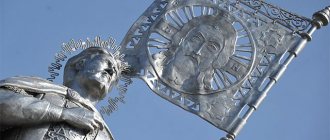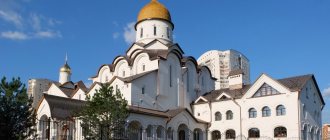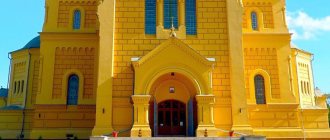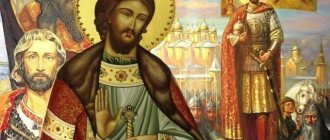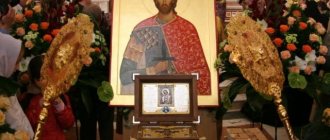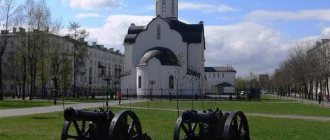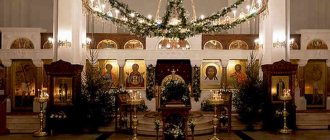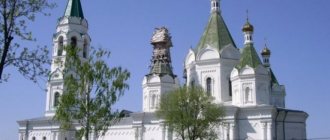One of the noblest pages in the history of our state is the period of the reign of Alexander Nevsky, the famous statesman and great commander. The characteristics of Alexander Nevsky are known to us from a story describing life, with which any schoolchild is undoubtedly familiar. This person is one of a galaxy of great statesmen whose actions led to the formation of great Russia.
Constant descriptions of brilliant historical exploits lead to the fact that the biography of the prince becomes the subject of essays in school. In the 8th grade, “Life” is included in the compulsory school curriculum, which undoubtedly forces many to study this topic. Knowing it is necessary not only for successfully passing the exam, but also for the comprehensive development of the individual at school.
Prince Alexander Yaroslavovich Nevsky. Years of life 1221 - 1263
Who is the story talking about?
A literary work written in the Nativity Monastery (Vladimir) tells us about the commander Alexander Nevsky. Born in Pereyaslavl in 1219. Father Yaroslav was a believer and a fair father, mother Theodosius is described as a quiet and submissive woman. From an early age, the future ruler showed interest in science and grew up dexterous and strong. Already at the age of 17 he took the main post in Novgorod, and at the age of 20 he gained wide fame among the population.
Metropolitan Kirill (namely, many scholars point to him as the author of the story) points out that the commander and strategist, before any important actions - campaigns or wars - invariably indulged in prayers. This further emphasizes the connection between the spiritual sphere and the Russian land: it is not for nothing that in the everyday life of that time the words were heard every now and then: “We are Russians, God is with us.”
Betrayal of the Holy See
Having received the label to reign from the Horde, Galitsky began to lie under the West in every possible way. He transferred his possessions to the ecclesiastical jurisdiction of Rome. That is, he betrayed the Orthodox faith, for which he received a crown as a gift, sent to him by Pope Innocent IV . At the same time, the papal nuncios also processed Alexander Nevsky . But he was much more far-sighted.
Pope. Detail from the fresco of Pope Gregory IX approving the Decretals, 1511.
“Having already repelled the onslaught of the Swedes and Germans, he clearly understood the true background of Roman diplomacy,” says historian Valery Shambarov . - Set up Rus', pit it against the Horde, and take what is left of our country into your hands. Nevsky refused, but Daniil agreed and even became involved in the pope’s politics: together with Hungary and Poland, he got involved in the war against the papal enemies. Why Russian soldiers fought and died at that time remains unclear. But when the Lithuanians began to gut Galicia and Volyn, dad didn’t lift a finger.
Shambarov notes that when the Chernigov princes with clouds of Polovtsians defeated Galitsky and captured Kiev, no one supported him. When the Mongol-Tatars invaded his lands, Galitsky completely fled to Hungary, clinging to the hope of creating a coalition with foreigners.
“But the prince and his ideas were simply driven away!” - states the historian.
The Pope encouraged him to challenge the Horde, promising a Western Christian coalition. Hell no! In 1259, this adventure ended in shameful capitulation. Galitsky was forced to tear down his own fortresses - Danilov, Lvov, Kremenets, Lutsk, Vladimir.
The Pope's army was led by the future ruler of Sweden, Birger Magnusson. Alexander wounded him in the face with a spear. Reconstruction of the appearance of Earl Birger. The author of the reconstruction is Oscar Nilsson
“As a result,” writes Victor Bober , an expert at the Strategic Culture Foundation, “after 90 years, Poland and Lithuania, essentially, without the slightest resistance, divided the defenseless Galician-Volyn principality among themselves. Lithuania later captured Kyiv, which was devastated by the Tatars thanks to Daniil.
What did you become famous for?
In short - battles and diplomacy. In 1240, detachments of Swedish knights invaded the territory of Rus' from the north-west. The clash between the sovereign's squad occurred on June 15, 1240 near the Izhora River. Based on the story of the life, one can judge the courage of the prince’s warriors: we are offered a description of six men who fought side by side with the prince: Gavrilo, Zbyslav, Yakov, Mikhail, Savva and Ratmir.
A year later, the sovereign went to war against the knights of the Livonian Order, who by that time had captured significant territory near Pskov and Novgorod. On April 5, 1242, a battle took place that went down in history as the “Battle of the Ice,” in which the knights were disgraced and expelled from the territory of the principalities. Such a defeat of enemies, as described in the work, became known far beyond the borders of Rus'.
From the story about the life of Alexander Nevsky, you can learn many personal characteristics of the prince. The narrator, describing the events, never ignores self-will (he could not tolerate the order of the residents of Novgorod gathering for the evening), and nobility (forgetting grievances, he was the first to come to the aid of Novgorod during the invasion), and courage (personally went to the Horde khan to agree on the fate of the Russian people), and competent government (military exploits were not the main goal, because after them it was necessary to restore cities and villages).
What about diplomacy?
After the death of Nevsky’s father, who became the dominant man in several principalities, Batu Khan called to bow. Gathering a small squad, the young sovereign set off. I didn’t intend to fight, I had to come to an agreement. After a long conversation with the khan, all honors were given to him as the governor of the Horde on the Russian lands, and assurances were also given of peace, which was guaranteed to the lands of Rus'.
The story also describes with quotes another case of nobility: Alexander’s brother, Andrei, who ruled in Suzdal, was severely punished by Batu for his self-will. The Mongol army devastated the lands of the Suzdal principality, opening it to destruction by a number of neighboring enemies. But Alexander came to the rescue - not only restoring the capital, but also, by his own will, again establishing his brother on the throne.
How is the sovereign described?
In moments of peace and quiet, Nevsky is a quiet and humble person, full of spiritual meekness. This is evidenced by the ruler’s constant appeals to prayers, to the patrons of his family in heaven. In turbulent moments of battle, the prince is courageous, ardent and merciless.
It describes unprecedented dedication in battle, which leads a huge human army, swiftness of action, invariably leading to victorious maneuvers, and after the battle - generosity towards those killed in battle, towards captured enemy people, towards the wounded and maimed. This ideal of a ruler: on the one hand, wise towards his subjects, and on the other, merciless towards his enemies, remained for a long time in ancient Russian history as one of the main archetypes of narratives.
The connection with the saints is constantly emphasized in the story and life, and the courage that is inherent in the prince is invariably determined by the signs that heaven gives. In particular, the story tells an incident when, during a battle, one of the elders, close to the commander’s headquarters, had a vision of the martyrs Boris and Gleb.
It is described as follows: an elder named Pelguy, during his next patrol, saw Boris and Gleb sailing across the sea in a boat “in scarlet robes” (crimson, dark red) “holding their hands on each other’s shoulders,” looking at the land. After this, Pelguy heard that one of the brothers, Boris, said: “Tell us to row, and let us help our relative, Prince Alexander.”
It is no coincidence that such lines are indicated in the essay: “relative” is a blood relative, a close soul. Nevsky is helped due to his relationship with the angels, with the forces from above. Therefore, even a small Russian army was able to defeat the Swedes in the battle, and the commander himself “wounded the king himself in the face,” which meant an unconditional victory. In addition, the narrator, describing the portrait of Alexander, compares it with images from the Bible: he has the strength of Samson, the beauty of Joseph, the wisdom of Solomon, and the courage of Vespasian.
Yu. K. Begunov. The Life of Alexander Nevsky as part of the 1st Novgorod and 1st Sofia Chronicles
| The site is connected to the Orphus system. If you see an error and want it to be fixed, select the corresponding piece of text and press Ctrl+Enter. |
[229]
Novgorod historical collection, vol. 9, Novgorod, 1959 [229]
— beginning of the page. OCR Sergey Trofimov.
The life of the Novgorod and Vladimir-Suzdal prince Alexander Yaroslavich Nevsky (1220-1263) is one of the most important sources for information about his life and activities and, at the same time, an outstanding monument of ancient Russian literature. Soviet researchers1) have repeatedly turned to the text of the so-called “chronicle” or “original” edition2) of the life according to individual published lists,3) including the 1st Novgorod Chronicle, junior edition3a) and the 1st Sofia Chronicle.3b) Most researchers joined the high assessment of the life of Alexander Nevsky as part of the 1st Sofia Chronicle, given by N.A. Polev: “This is a kind of poem. Constituting a transition from ancient heroic songs, such as “The Tale of Igor’s Campaign,” to the purely scholastic monuments of the later ones, this poem or poetic story is extremely curious, as a monument to Russian literature of the 13th century. It is included in many lists of chronicles, but ignorant scribes mixed it with historical news that was in the Novgorod and other chronicles."4)
Despite the detailed works of V. I. Mansikki,5) N. I. Serebryansky,6) S. A. Bugoslavsky7) and others, the life of Alexander Nevsky in the “original” edition remained unstudied by modern methods of textual criticism: there is no critical edition of the life, the literary the history of the “original” edition, its relationship to the chronicles, to the so-called “secular biography” of Prince Alexander, etc. This shortcoming has already been pointed out by D. S. Likhachev8) and I. P. Eremin.9) The unsatisfactory state of studying the most important source on the history of Rus' of the 13th century - the life of Alexander Nevsky “initial” or “chronicle” [230]
the editors are one of the reasons for the uncritical coverage of historical facts: the exaggeration of the role of Prince Alexander Yaroslavich, the conqueror of the Germans and Swedes and intercessor for the Russian land, before the khan, and insufficient attention in the study of his internal politics as a prince who acted in the interests of the Suzdal nobility and brutally suppressed popular uprisings .
In this work, we will consider the life of Alexander Nevsky only as part of the Novgorod 1st Chronicle of the younger edition and the Sofia 1st Chronicle.
Was the life of Alexander Nevsky written for one of the Novgorod vaults of the 13th century? The Novgorod 1st Chronicle of the older edition (Synodal list) did not contain a life.
A. A. Shakhmatov10) came to the conclusion that excerpts from the life of Alexander Nevsky are inserts into the Commission list of the Novgorod 1st Chronicle of the younger edition, in comparison with the Synodal list, under the years 1240-1242, 1245, 1251-1252. The conclusions of A. A. Shakhmatov were supported by V. I. Mansikka11) and S. K. Shambinago.12)
A comparison of the Synodal list with three lists of the Novgorod 1st Chronicle of the younger edition: Commission, Academic and Tolstoy shows that neither the chronicle news of the Synodal list served as a source for the life of Prince Alexander, nor the news of the life were the source of news of the Synodal list.
Novgorod news from 1238-1263 is completely absent from the life of Prince Alexander Nevsky. about the marriage of the prince, about the construction of cities along the Sheloni River, about the discord and disputes of Prince Alexander with the Novgorodians, about his departures from Novgorod to the Suzdal land, there are no details about the Battle of the Ice known to the Novgorod chronicler, there is no story about the German embassy after the Battle of the Ice, about the campaign Alexander's death in 1256, about Alexander's reprisal against his son Vasily and his warriors, about the Tatar census. But the life contains many details unknown to the Novgorod chronicler: a description of the “miracles” and exploits of Prince Alexander’s warriors in the Nevsky and Ice Battles, a description of the prince’s appearance, his speeches addressed to the Pskovites in 1242 and to the princes who went on a campaign against Yuryev in 1262 ., a story about the pope's embassy, a detailed story about the death and burial of the prince and about the posthumous miracle with a letter.13) Noteworthy is the difference in the depiction of Prince Alexander in the life and in the Synodal list of the 1st Novgorod Chronicle of the older edition. What attracts the author in his life is not so much the exact adherence to the chronology of events and historical realities, but rather the image of the prince himself, dear and close to his contemporaries. The Synodal List briefly reports on the facts of Alexander's reign as the Prince of Novgorod; his quarrels with the Novgorodians and harsh reprisals against his enemies are not hushed up. [231]
Since the Synodal list in the part from 1234 to the end is written in the handwriting of the first half of the 14th century,14) it can be assumed that the life of Alexander was not in it, at least in the first half of the 14th century. The chronicle news of the Synodal list about Alexander is much more complete and detailed than the news of his life. The Novgorod chronicler under 1263 notes the high merits of the prince, who “worked a lot for Novgorod and Pskov and for the entire Russian land.” Novgorodians honored the military valor and exceptional merits of Prince Alexander, the conqueror of the Swedes and Germans, but could not forgive him for violating the rights of the Novgorod boyar-veche republic.
During the long years of his reign in Novgorod (1236-1252), Alexander Yaroslavich tried to undermine the economic and political significance of the Novgorod boyars, took away lands from them, made judicial decisions in his own name, took away the bank of the Tre and sent his warriors there for a fur tribute, distributed Novgarod volosts his supporters and the Vladimir nobility.15) At the same time, he contributed to the conduct of a Tatar census and brutally suppressed popular unrest. In the contractual document of 1272 between Novgorod and Yaroslav Yaroslavich, we read a condemnation of Alexander’s internal policy: “And what, prince, did your brother Alexander commit violence in Novgorod, and that one, prince, retreat.”16) It can be assumed that the life was not included in the chronicle, because the description of Prince Alexander as a Suzdal prince and local saint in his life did not coincide with the description of the prince in the Synodal list of the chronicle, or perhaps the chronicler did not know the life at all.
In the 15th century, the life of Alexander Nevsky was already read as part of the 1st Novgorod Chronicle, junior edition, in the Commission (senior list of the 50-60s of the 15th century), Academic and Tolstoy lists.
After the chronicle article of 1239 about the marriage of the prince to the Polotsk princess, the daughter of Prince Bryachislav, and about the construction of cities on the Sheloni River, the life begins in 1240 with the words “O our Lord God...”. Extracts from the life alternate with chronicle news from the Novgorod 1st chronicle of the older edition, up to 1252. Under 1252 there is a final lament “Oh, grief” and a description of the death of Prince Alexander and the miracle with the letter. The compiler of the code did not even notice that Alexander died twice in his book, in 1252 and in 1263. V. Mansikka and S. Shambinago pointed out in detail all the episodes of the “original” edition of the life, which are contained in the Novgorod 1st Chronicle of the younger edition, so we will not dwell on this specifically. Let us pay attention to the way in which the chronicler skillfully interweaves life stories with chronicle news. Here are examples from the description of the Battle of the Neva: [232]
| Synodal list of the 1st Novgorod Chronicle, senior edition: | Commission list of the Novgorod 1st Chronicle of the younger edition: |
| “In the summer of 6748. Svea came in great strength, and Murman and Sum, and there was a great multitude in the ships; You are with the prince and with your piskupi; and stasha in the Neva, the mouth of the Izhera, wanting to absorb Ladoga, just the river and Novgorod and the entire Novgorod region."17) | “Behold, the king of the part of Rimsky, from the midnight country, heard such courage of Prince Alexander, and thought to himself: “And I will go,” he said, “to captivate the land of Alexander.” And gathered your multitude, your great strength Zelo Sveya with the prince and her squeaks , and Murman, and Sum, and Em, and then filled the ships with many of their regiments and moved in great strength, puffing with the military spirit, and came to the |
In the same way, in the Commission list of the Novgorod 1st Chronicle of the younger edition, excerpts from the life of the “original” edition are interspersed between the chronicle news. Here is a description of the Battle of the Ice according to the Commission List (the text is identical to the text of the Synodal List of the Novgorod 1st Chronicle of the older edition):
«In the summer of 6750. Prince Alexander with the Novgorodians and his brother Andrei and the Nizovians went to the Peipus land in the German winter.
, in great strength, let them not boast, crying: “Let us reproach the Slovenian language below ourselves.”
Pskov had already been taken, and they were imprisoned just after that. And Prince Alexander walked all the way to Pleskov; and Prince Pskov expelled, and Izima Nemtsi and Chyud, and, having shackled them, sent them to Novgorod, and he himself went to Chyud. And as if they were on earth, let the entire regiment live; and Domash Tverdislalytsya and Kerbet, in a scuffle, killed that Domash, the mayor’s brother, an honest husband, and beat others with him, and others with the hands of izimash, and Iney came running to the prince’s regiment. The prince turned back towards the lake; Nemtsi and Chud followed them. Having seen [233] Prince Alexander and the Novgorodians, he placed a regiment on Lake Chudskoye, on Uzmen, at the Raven Stone;
and Lake Chudskoye came : there were many of both.
There were many brave people among Prince Oleksandr; Just as Davyd’s minion of old was strong in strength, the men of Alexander were also filled with the spirit of war, and they beat their hearts like a lion: and Rkosha: “Oh, our honest and noble prince, now is the time to lay down our heads for you.” Prince Alexander raised his hand to the sky and said: “Judge, O God, and judge my truth from the tongue of the great. Help me, Lord, as Moses of old did against Amalek and my great-grandfather Yaroslav did against Svyatopolk. Then it was Saturday, the rising sun, and the most powerful regiment of Nemtsi and Chud, and a pig broke through the regiment
; see ice: everything is covered in blood.
I heard from a self-witness, and speeches, that I saw the regiment of God and came to the aid of Alexandrov in the air. And with the help of God I defeated both Saint Sophia and the holy martyr Boris and Gleb, with whom I shed blood for the sake of ancient times;
and the Germans fell, and Chud dashed their shoulders; and chasing 7 versts on the ice to the Sobolichka shore; and Chudi fell into disgrace, and German 500, and 50 others with his hands and brought to Novgorod. And Bisya April at 5, in memory of the holy martyr Theodulus, for the praise of the Holy Mother of God, on Saturday ."19)
In the life of Alexander in the Novgorod 1st Chronicle there are additions that do not go back to the news of the Synodal list: they were added by the compiler of the Novgorod 1st Chronicle of the younger edition. These are common characteristics of Alexander and his mother Theodosia:
1) “from Mother Theodosius, God-loving right, pious and God-pleasing merchant as she is, great deeds are enlightened, like the monastic rank awarded to her and the ever-remembered Theodosius, mother of Prince Alexander.”20)
2) “God-worn and pious and affirmed by God, and a champion of the more Orthodox faith of Christ, dear Alexander.”21)
Thus, the compiler of the Novgorod 1st Chronicle used the life of Alexander, which preserved all the episodes, including “about the 6 brave men”, and about the miracle beyond Izhora, the full version of the story about the burial and miracle.22) The life was divided into fragments and separated according to weather news. The following stories were published from it, which are presented more fully and in more detail in the 1st Novgorod Chronicle of the older edition. The compiler approached his task consciously, creating the image of a locally revered prince as a saint [234]
warrior of the Russian land. In the margins of the senior Commission list there is a note: “The Tale of Prince Alexander.” This is how the compiler titled the compilation of his life and chronicles. This compilation should be considered a new, second edition of the life of Prince Alexander. In the archetype of the Commission, Academic, and Tolstoy lists, which arose no later than the 50s of the 15th century, the life was already contained. A. A. Shakhmatov23) assumed that borrowings from the “original” edition of the life ended up in the Novgorod 1st chronicle of the younger edition from the 1448 code, and in the 1448 code the life of Alexander was added from an all-Russian chronicler, such as the Laurentian Chronicle. Among the additions to the 1448 codex, A. A. Shakhmatov also includes “The Tale of the Murder of Mikhail of Chernigov,” the news of the death of Yaroslav Vsevolodovich in the horde in 1246, a brief message about the capture of Constantinople by the crusaders in 1204, and the story of the Battle of Kulikovo in 1380. However, later A. A. Shakhmatov24) abandoned the hypothesis of the existence of the 1448 vault. A. A. Shakhmatov, and after him M. D. Priselkov25) and D. S. Likhachev26) believe that the main source of the family of Novgorod chronicles - Novgorod 1st, Novgorod IV, Sofia 1st - was the Novgorod-Sophia corpus early 30s of the 15th century. D. S. Likhachev believes that it was compiled under the Novgorod Archbishop Euthymius.27)
It is obvious that in the direct sources of the Novgorod 1st Chronicle of the younger edition, in the Synodal list and the Sofia Chronicle, compiled at the court of the Novgorod archbishop in the XII-XIV centuries (according to A. A. Shakhmatov - “Sofia Temporary”), there was no life of Alexander Nevsky . It appeared as a result of additional verification of the Novgorod 1st Chronicle of the younger edition according to the Novgorod-Sofia code of the 30s of the 15th century.
The 1st Sophia Chronicle of the first edition, compiled in the 40-60s of the 15th century by Moscow scribes,28) was preserved in two lists of the 15th century - the Obolensky and Karamzinsky lists. Both lists contain the life of Alexander Nevsky, divided into episodes and combined with chronicle news from 1240-1252, i.e., the same as in the Novgorod 1st Chronicle of the younger edition. If the 1st Novgorod Chronicle of the younger edition placed the life immediately after the chronicle news of Alexander’s marriage, then the 1st Sofia Chronicle placed the life after the chronicle article about the capture of Kyiv by Batu, following the article about Alexander’s marriage.
In the 1st Sofia Chronicle, as well as in the 1st Novgorod Chronicle, the story of the life of how Alexander went to the horde to beg military service from the khan is omitted, the story of the life of the campaign against Yuryev in 1262 is not used, there is no news of the life about the illness and death of the prince. Just like in Novgorod 1st [235]
chronicle, in the 1st Sofia Chronicle the story of Alexander’s death is read twice under 1252 and under 126329)
A. A. Shakhmatov30) noticed that in the 1st Sofia Chronicle the life of Alexander Nevsky was used more fully than in the Novgorod Chronicle. 1st chronicle of the younger edition. For example, episodes from the life, omitted or replaced by chronicle news, in the Novgorod 1st Chronicle of the younger edition, in the Sofia 1st Chronicle are used in full: the destruction of the city of Koporye in 1241, the liberation of Pskov and the Battle of the Ice are told closer to the text of the life than in the Novgorod 1st Chronicle. The story “about the multiplication of the Lithuanian language”, omitted from the 1st Novgorod Chronicle, is used. Thus, the war with the Lithuanians in the 1st Sofia Chronicle is reported twice in the words of the life under 1242 and in the words of the chronicle under 1245-1246. In more detail than in the 1st Novgorod Chronicle, the 1st Sofia Chronicle uses the life story about Alexander Nevsky’s trip to the horde.
Skillfully using the text of both the “original” edition and the “special” or prologue edition of the life, 31) the chronicle news of the 1st Novgorod Chronicle of the senior edition, the author of Sophia. The 1st chronicle embellishes the story of Alexander as fully as possible. Instead of “Prince Alexander” in the 1st Sofia Chronicle, the full title is used everywhere: “Grand Duke Alexander Yaroslavich” and the full title is called “Grand Duke Yaroslav Vsevolodovich” and “Grand Duchess Feodosia”. In the 1st Sofia Chronicle, all Moscow princes are called great, the idea is consistently held that the Moscow great princes trace their ancestry from Vladimir Svyatoslavich, through Vladimir Monomakh, Vsevolod the Big Nest, Alexander Nevsky, Dmitry Donskoy. In accordance with this, the code has the name: “Chronicle of the Russian Land.”
Archbishop Spiridon is called “Novgorod”, Batu’s kingdom is called a “power”, in the words of Metropolitan Kirill “zaide the sun of the land of Suzdal”, “Suzdal” is replaced by “Russian”. In the final phrase, after the words “who worked a lot for the Russian land and for Novgorod and for all the cities and for Pyskov,” it was added “and for the whole great reign, giving their lives for the orthodox faith.” In the 1st Sofia Chronicle, the life of Alexander begins with a short preface, found only in the list of the collection by N.P. Likhachev32) and in the “special” edition: “About our Grand Duke Alexander Yaroslavich, about the smart and meek and sensible, about the brave, namesake of Tsar Alexander of Macedon, similar to Tsar Alevkhys, strong and brave. Sitsa had a story about him, but the god of summer told him according to his truth. And may God bless his days and bless him for his glory.”
Certain passages from the “original” version of the life are widespread. [236]
| Original edition. (according to the list published by V. I. Malyshev): | Sophia 1st Chronicle: |
| “In the same way, Prince Oleksandr would be invincible without running.” | “The same great Alexander Yaroslavich ran everywhere, but is invincible in no way.” |
This passage is also read in the “special” edition and in the Likhachevsky list. A description of the glory of Prince Alexander was widespread.
| Original edition (according to the list published by V. I. Malyshev): | Sophia 1st Chronicle: |
| “And I began to hear the name of Oleksandrovo on all pages and to the measure of Khulozhskago and to the Arabian Mountains, and to the land of the Varangian Sea and to Rome.” | “And the name of Grand Duke Alexander Yaroslavich began to be known throughout all countries: from the Varangian Sea and to the Pontic Sea and to the Khupozhskaya Sea and to the country of Tiberias and to the Ararat Mountains, to the land of the Varangian Sea and the Arabian Mountains, even to the Great Rome. For fear, spread his name before tens of thousands and before thousands of thousands.”33) |
All these decorations and additions, obviously, were brought in not only for decorative purposes, but with the aim of exalting and glorifying Alexander Yaroslavich as an all-Russian holy warrior. The all-Russian character of Alexander’s exploits in his life comes to the fore. In the creation of these decorations one can feel the experienced hand of a Moscow scribe who revised the Novgorod vault. He took as a basis the Novgorod-Sophia codex of the 30s of the 15th century, which included the life in the chronicle, but in a more complete form than the Novgorod 1st chronicle of the younger edition.
Thus, the Novgorod 1st Chronicle of the younger edition and the Sofia 1st Chronicle give us two options for a completely new edition of the Life, significantly different from the “original” edition of the Life. Let's call them the first and second types of the second edition.
It can be assumed that the reworking of the life of Alexander Nevsky in the Novgorod 1st and Sofia 1st chronicles is associated with the activities of Archbishop Euthymius II, 34) who tried to raise interest in Novgorod antiquity and local saints by establishing a ritual of commemoration of the Novgorod princes and saints, in including Varlaam Khutynsky and Archbishop John, Prince Alexander and his mother Theodosia, buried in the Yuryevsky Monastery. The treatment of the life of Saint Prince Alexander is associated with the claim [237]
Euphemia on the exclusive role of Novgorod and the seniority of the Novgorod archbishop's see.
So, the life of Alexander Nevsky was not contained in the Novgorod chronicles of the 13th-14th centuries. The new, second edition of the life of Alexander Nevsky was compiled for the chronicle in the 30s of the 15th century by the compiler of the Novgorod-Sophia corpus based on the list of the life of the “original” edition, close to the list of the life published by V. I. Malyshev,35) and news of the Novgorod 1- th chronicle of the older edition.
When using the second edition of the life of Prince Alexander Nevsky as a historical source, it is necessary to take into account, firstly, the Novgorodian nature of this edition, and secondly, its secondary nature (in relation to the text of the “original” edition). A special study must be devoted to the study of the oldest “original” edition of the life according to all lists in collections and chronicles.
NOTES
1) N. P. Gratsiansky
.
German aggression in the Baltic states in the XIII-XV centuries - “Marxist Historian”, 1938, book. 6; V. T. Pashuto
.
Alexander Nevsky - “Scientific Notes of Leningrad State University”, No. 36. Series of Historical Sciences, vol. 3, L. 1939; His own.
Alexander Nevsky and the struggle of the Russian people for independence in the 13th century, M. 1951;
His own.
Decisive victories of the Russian people over the Swedish and German invaders (1240 and 1242) - § 9 from Ch.
5, in the book “Essays on the history of the USSR. The period of feudalism", part I, M. 1953, pp. 838-853; His own.
The heroic struggle of the Russian people for independence (XIII century), M. 1966;
A. N. Nasonov.
Mongols and Rus' (History of Tatar politics in Rus'), M.-L.
1940; S. V. Bakhrushin
. Alexander Nevsky and the struggle of the Russian people against German aggression in the 13th century - “Bulletin of the USSR Academy of Sciences.” M. 1942, No. 4, etc.
2) “Initial” or “chronicle” edition is a term introduced by V. O. Klyuchevsky to designate the oldest edition of the life, compiled, as Klyuchevsky assumed, for the chronicle.
3) Mainly according to the Pskov-Pechora list published by N.I. Serebryansky ( N.I. Serebryansky
.
Old Russian princely lives. M. 1915, appendices, pp. 109-112, 117-120), according to a list from the 2nd Pskov Chronicle (PSRL, vol. V, St. Petersburg. 1851, pp. 2-6; A. N. Nasonov.
Pskov Chronicles Issue II, M. 1955, pp. 11-16), according to the Leningrad list (
V.I. Malyshev
. Life of Alexander Nevsky - according to a manuscript from the mid-16th century. Grebanshchikov Old Believer community in Riga - TODRL, vol. V, M.-L. 1947, pp. 185-193).
3a) PSRL, vol. V, St. Petersburg. 1851, pp. 146-151; Novgorod Chronicle according to the Haratean Synodal list. St. Petersburg. 1888. pp. 252-274 (the notes give all the options from Nov. 1 chronicle of the younger edition); Novgorod first chronicle of the older and younger editions, M.-L. 1950, pp. 77-84.
3b) Sofia temporary book or Russian Chronicle from 862 to 1534, ed. P. Stroev, M. 1820, part 1, pp. 249-274; N. Polevoy
. History of the Russian people, vol. IV. M. 1833, appendices, pp. 42-61 (extract from the Sofia Vremennik); PSRL, vol. V, St. Petersburg. 1851, pp. 176-191; PSRL, vol. V, ed. 2, no. 1, L. 1925, pp. 220-239. Currently, preparations are underway for publication of the protograph of the 1st Sofia Chronicle according to the GPB list from the Pogodinsky collection. No. 1409 and others, conducted by S. M. Kashtanov (Moscow).
4) N. A. Polevoy
. History of the Russian people, vol. IV, M. 1833, p. 122.
5) V. I. Mansikka
, Life of Alexander Nevsky (Analysis of editions and texts) - PDP, SXXXX, St. Petersburg. 1913.
6) N. I. Serebryansky
. Old Russian princely lives. M. 1915.
7) S. A. Bugoslavsky
, On the question of the original text of the life of Grand Duke Alexander Nevsky.
( V. Mansikka
. Life of Alexander Nevsky. Analysis of editions and text. PDP, vol. CXXX, St. Petersburg, 19131 - IORYAS, vol. XIX, book 1, St. Petersburg. 1915, pp. 261-290.
 D. S. Likhachev
D. S. Likhachev
. Galician literary tradition in the life of Alexander Nevsky. TODRL, vol. V, M.-L. 1947, pp. 36-38.
9) I. P. Eremin
. The life of Alexander Nevsky, in the book: “Fiction of Kievan Rus of the 11th-13th centuries.” Compilation, translations and notes. I. P. Eremina and D. S. Likhachev. GIHL, M. 1957, p. 356.
10) A. A. Shakhmatov
. Report on the 12th awarding of the Metropolitan Macarius Prize, St. Petersburg. 1907 p. 90; His own. Review of Russian chronicles of the XIV-XVI centuries, M.-L. 1938, p. 164.
11) V. I. Mansikka
. Decree. works., pp. 59-68.
12) S. K. Shambinago
. The legend of the Massacre of Mamayev. - SORYAS, t. 81, St. Petersburg. 1906, pp. 64-66. He considered the life of Alexander Nevsky as part of the Soph. 1st and Resurrection Chronicles and called the new edition “second”.
13) Happy Novg. With the 1st chronicle we compare the copy of the life of Alexander Nevsky in the “original” edition according to the latest edition by V. I. Malyshev. (TODRL, vol. V, M.-L. 1947, pp. 185-193).
14) A. N. Nasonov
. Novgorod 1st Chronicle of the older and younger editions ed. USSR Academy of Sciences, M.-L. 1956, p. 5.
15) Essays on the history of the USSR, XI-XIII centuries, ed. Academy of Sciences of the USSR, M. 1953, pp. 773-774.
16) Certificates of Veliky Novgorod and Pskov. Ed. S. N. Valka. Ed. USSR Academy of Sciences, M.-L. 1949, p. 11.
17) Novg. the first chronicle of the older and younger editions, p. 77.
18) Ibid., p. 251.
19) Ibid., pp. 205-206. 78. {78 is printed at the end of the note, after the period. Presumably a typo. OCR
}
20) Ibid., p. 290.
21) Ibid., p. 292.
22) For comparison, see the list of the life from the collection of the Institute of Russian Literature (Pushkin House) of the USSR Academy of Sciences, containing all the episodes of the life in full ( V.I. Malyshev
. Life of Alexander Nevsky, pp. 185-193).
23) A. A. Shakhmatov
. Review..., page 164.
24) D. S. Likhachev
. Russian chronicles and their cultural and historical significance, M.-L. 1947, p. 448.
25) M. D. Priselkov
. History of Russian chronicles, M.-L. 1940, p. 150.
26) D. S. Likhachev
. Russian Chronicles, pp. 312-316.
27) Priselkov believed that Novg.-Sof. the code was compiled in Moscow (See M.D. Priselkov
. Uk. cit., p.150).
28) A. A. Shakhmatov
. Review..., page 213.
29) The 1st Sofia Chronicle of the second edition moved the article about the death of Alexander Nevsky to 1263.
30) A. A. Shakhmatov
. Review..., page 212.
31) This edition was published by Mansikka (under the title “second”) according to the list of the State Historical Museum from the Uvarov collection, No. 514 (369), 16th century. ( V.I. Mansikka
.
Uk. cit., appendices, pp. 11-14) and N.I. Serebryansky based on the Rumyantsev manuscript. museum from the collection. Piskarva, No. 530, XVII century. called "special". ( N.I. Serebryansky
. Uk. soch., appendices, pp. 121-123).
32) Published by Mansikka (see V.I. Mansikka
. Uk. cit., appendices, pp. 125-137).
33) For more details, see ibid., pp. 69-74.
34) V. L. Komarovich
.
Literature of Novgorod of the XIV century. - in the book: “History of Russian Literature”, ed. USSR Academy of Sciences, M.-L. 1945, vol. 1, second half pp. 256-261; D. S. Likhachev
. Russian Chronicles, pp. 312-313.
35) S. K. Shambinago unjustifiably considered the Academic copy published by Mansikka to be closest to the text of Soph. 1st chronicle and attributed the compilation of the second edition to the end of the 14th century ( S.K. Shambinago
. The Tale of the Massacre of Mamayev, p. 64).
Write to us
How does the work end?
As befits a hagiography, according to plan, the final part invariably describes the death of the main character. The next (fourth) trip to the Horde in 1262, the result of which was the agreement of Khan Mongke not to take any of the Russian people to conquer new territories, led to a long illness of the prince.
In 1268 and died in the city of Gorodets. The author of the life describes a “wonderful and worthy of memory” miracle: during the burial, Metropolitan Kirill III, following tradition, was supposed to place a “farewell letter” into the sovereign’s hand. But during the ceremony, the hand of the deceased himself reached out and took the letter from the hand of the amazed metropolitan.
Significance for history
Until the end of the 16th century, Alexander Nevsky was a role model for a whole list of statesmen of all ranks. One of the monasteries in St. Petersburg bears his name, and the order of the same name was awarded to dozens of commanders who showed courage and courage during the Great Patriotic War.
“Noble protector of people,” “spiritual leader,” “wise protector”—dozens of positive epithets characterize the prince from various angles.
His loyalty to ideals, desire to protect the state and spiritual kindness are forever enshrined in “The Life of Alexander Nevsky” - one of the monuments of ancient Russian literature. Share on social media networks
Glorious Reward
The Order of St. Alexander Nevsky was established by Catherine I in 1725. It was awarded to Field Marshal Alexander Menshikov and many prominent military leaders and courtiers. In 1942, the USSR established a new Order of Alexander Nevsky as an award for the command staff of the Red Army. In particular, three orders were awarded to Lieutenant Colonel Ivan Borisenko, commander of the 536th Anti-Tank Artillery Regiment. In 2010, the Order of Alexander Nevsky was again restored. Artist Vasily Lanovoy, President of Belarus Alexander Lukashenko, Director of the Foreign Intelligence Service Sergei Naryshkin and many others became knights.
The great commander was brilliantly played by Nikolai Cherkasov. Photo: movie poster


